Sigma 70mm f/2.8 EX DG Macro review
Here is yet another lens in Sigma’s drive to produce lenses suitable for today’s modern photographer. At 70mm, the focal length is ideal for cropped sensor cameras yet the lens is still suitable for full frame. We take a look at how it performs.
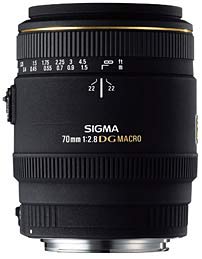 Specifications
Specifications
- Focal Length 70mm
- Aperture f/2.8
- Angle of view 34.3º
- Filter size 62mm
- Construction 10/9 elements/groups
- Focus type Floating system
- Closest focus 250mm (1:1)
- Weight 527g
- Dimensions 76x95mm
- Mounts available Sigma, Canon, Nikon (D), Sony, Pentax
- Tripod bush No
- Price (SRP) £339.99p
Build and Handling
As one of Sigma’s EX range, the build, handling and finish of this lens falls into the higher end of our expectations and this optic does very little to disappoint. The matt black finish is now known to be hardwearing and the body of the lens feels robust enough for it to be put to some hard work. The manual focus ring is nicely torqued and takes almost three quarters of a turn to move through the full focus range. This range however, does take the focus point down to 25cm and a full one to one image size, true Macro. This does extend the length of the lens by some 52mm and reveals a reproduction ration scale on the single trombone. This trombone displayed no sign of play during extension.
A focus limiter switch sits on the side of the barrel and operates on each side of the half metre mark, restricting the distance the lens has to travel through during autofocus. It can be switched off to achieve full travel. Being designed as a macro lens, the AF is not lightning, due to the finer pitch of the focussing motor but with the limiter engaged, it is fast enough for most purposes.
Physically, the lens is no smaller than it’s 105mm cousin, although it has lost the push-pull action of the focus ring needed to activate the manual/auto focus changeover. It has also lost the distance window, with distances now being marked on the focus ring.
The lens comes supplied with a screw-in lens hood that gives the alternative of using popular 77mm filters on the end of the hood, and is packed in it’s own zip-topped semi-hard pouch.
Optical quality
Sigma’s reputation for top quality prime macro lenses is upheld here with this 70mm offering. Designed to have a similar useful range as the very popular 105mm lens on a full frame camera, the optical performance more than matches up too. The lens proved to be sharp right from the outset at f/2.8 and stays that way right through to between f/11 and f/16 where reciprocity starts to come in and degrade the image slightly. Even this though, is well controlled and there is no massive falloff as with some lenses.
Distortion, measured with the Imatest distortion module is negligible with a reading of 0.17% pincushion, which is visually undetectable.
Chromatic aberrations are so well controlled that similar, negligible readings were recorded throughout the aperture range and are as good at the edge as in the centre.
I have harped on about Sigma’s DG coating, designed to reduce reflections from shiny sensors bouncing around inside the lens, and its positive effect on lens contrast. Well, I’m doing the same again here, as the contrast delivered by this optic is excellent. Colour reproduction is neutral, with no obvious casts and the incidence of flare never reared it’s ugly head in normal use.
The focal length is an ideal one for portrait photography as well as the intended macro use and the nine bladed aperture does make for pleasant OOF backgrounds.
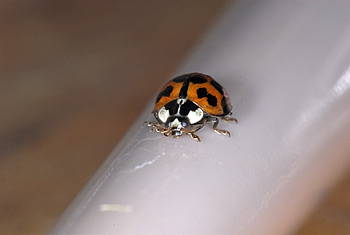 | 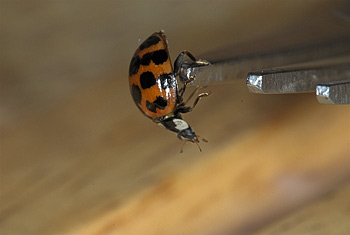 Left and right: two photos of a Harlequin Ladybird at 1:1 |
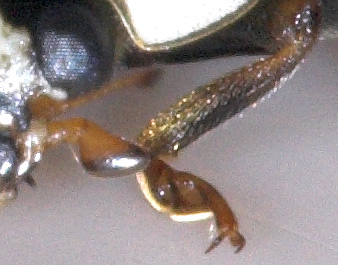 100% crop of the image above left. |
Click on each comparision photo below to view full size versions
Below is our lens test data. To find out how to use these graphs look at this article: How we test lenses
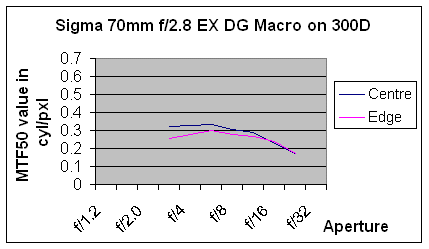
Verdict
Long enough in its focal length to be useful for many forms of macro photography and virtually the ideal for portraiture (on a cropped sensor) the lens also lends itself to many other short telephoto uses too. Optically it is probably the best of Sigma’s already highly rated macro line-up, coming straight in with razor wide-open images. The lens is also capable of being used on ‘full frame’ sensors and 35mm cameras, so I should think it will find its way into a number of photographers inventories.
In summary, the positive points of the Sigma 70mm f/2.8 EX DG Macro are:
![]() Excellent optical quality from wide open
Excellent optical quality from wide open
![]() Ideal focal length for cropped cameras
Ideal focal length for cropped cameras
![]() Sensible focus limiter works at both sides of the mark
Sensible focus limiter works at both sides of the mark
The negative points are:
![]() Extending front element
Extending front element
![]() No HSM motor means AF is a little whiny
No HSM motor means AF is a little whiny
For the latest price on the Sigma 70mm f/2.8 EX DG Macro look here
Discuss this lens and other related lens subjects here
Test by Ian Andrews www.wildaboutkent.com
I use my example on both full-frame and APS-C size sensor Canon DSLRs and it is superb on both. With the smaller sensor cameras, you gain the advantage of greater than 1 to 1 macro too.
The lens does extend considerably with closer focusing and the AF is a little noisy but it is very accurate and reasonably fast for this type of lens. In any case, when focusing so closely, it is usually preferable to focus manually.
Great lens.
David Chamberlain
Add your message
Please login here or if you've not registered, you can register here. Registering is safe, quick and free.
photodo Stats
428 MTF tests
74 in-depth photodo reviews
100+ users join each day
Help the lens community by reviewing or rating a lens today via our lens search
Latest Lens Reviews
- Chinon 28mm f/2.8 Vintage Lens Review
- Canon EF 70-200mm f/4L IS II USM Lens Review
- Samyang AF 85mm f/1.4 EF Review
- Sigma 70mm f/2.8 DG Macro Art Review
- Samyang AF 24mm f/2.8 FE Review
- Meike 50mm f/1.7 Review
- Tamron 70-210mm f/4 Di VC USD Review
- Lensbaby Burnside 35mm f/2.8 Review
- Asahi Super Takumar 50mm f/1.4 Review
- Asahi Super-Multi-Coated Takumar 135mm f/3.5 Review


